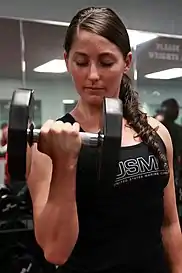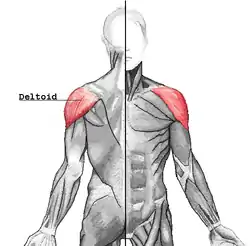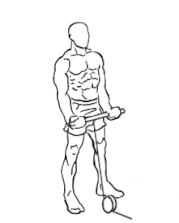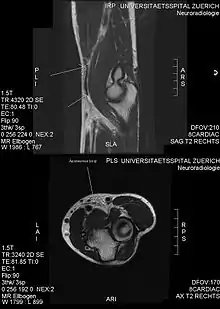Biceps curl
Biceps curl is a general term for a series of strength exercises that involve brachioradialis, front deltoid and the main target on biceps brachii.[1] Includes variations using barbell, dumbbell and resistance band, etc. The common point amongst them is the trainee lifting a certain amount of weight to contracting the biceps brachii, and tuck in their arms to the torso during the concentric phase. Once the biceps brachii is fully contracted, then return the weight to starting position during the eccentric phase.

Overview
Mechanism
The biceps curl targets explicitly the biceps brachii, which is located on the front part of the arm between the shoulder and the elbow. This muscle's primary function is elbow flexion and forearm supination. The biceps also has two heads known as the long head and the short head.[2] The biceps brachii during the radioulnar joint (forearm) supinating phase is a stronger elbow flexor. The biceps brachii during the elbow flexing phase is a stronger forearm supinator.[3] During the elbow flexion phase, motor units in the lateral portion of the long head of the biceps are preferentially activated. Still, during the forearm rotation phase, motor units in the medial portion are preferentially activated.[4]
Form
This movement usually starts from the elbows and is in a fully extended position (against the thigh) with a supinated grip. Then biceps begin contracting to lift the weight, upward to shoulder. The second part of the motion is the eccentric phase that has the elbow joint slowly extending as weight is lowering back to the starting position.[5]

Although this exercise has many variations, a common factor of them is a 'curling' motion, where a weight (attached to, or used in conjunction with, an item of equipment) is lifted until the biceps is fully contracted, which is approximately at the shoulder level.[6] Some variations include partial reps (such as the " 21 Gun salute") focusing on the top or bottom parts of the bicep.[7] With the elbows and upper arm is remaining close to the body.[8]
This contraction and extension together constitute a single repetition. As with most weight training exercises, results from biceps exercises can be maximized with a proper understanding of flexion.
Elbow position

In the origin biceps curl[9] and many other variations,[10][11][12] the elbows are usually staying to the side of the torso, and keep stationary. By keeping elbows in position to avoid them rise higher than the weight's center of gravity, hence prevent the tension on biceps terminated before the full contraction is achieved.[13]
Shoulder position
A prevalent mistake is people trying to cheat by using the momentum to swing the weight up to the top. In this exercise, the idea is to stimulate the bicep. The shoulder is supposed to stay pullback tightly over the torso,[14] and try not to sway. The anterior deltoid should be recruited as the stabilizer.[15]
Range of motion
To maximize the activation of biceps, conducting this exercise in the fullest range is recommended for everyone.[16] But for advanced trainers, they can apply a different variation of range in order to acquire some particular emphasis muscle activation. Some may argue that the tension on muscle is most significant during the mid-range, practice biceps curl with a half range of motion to let muscle generate the most force.[17]
The research found that the preacher curl targets the long head of the biceps significantly only when the arm was almost fully extended, and the range of motion was short. On the other hand, the incline dumbbell curl and the regular biceps curl activated the biceps brachii throughout the entire range of motion. They may be more effective in maximizing the biceps activation.[18]
Muscles Used[19]

Target muscle
Synergists
Stabilizers
- Anterior Deltoid
- Upper Trapezius
- Middle Trapezius
- Levator Scapulae
- Wrist Flexors (Underhand grip)
- Wrist Extensors (Overhand grip)
Variations

Several variations on the biceps curl by using different equipment, forms, and volume. But the general idea is still to target the biceps activation. Below are some typical variations using common equipment that are prevalent among trainers.
Dumbbells
- Dumbbell Incline Curl: With an adjustable bench positioned at a 45-degree angle, one could perform incline biceps curls with dumbbells. Incline biceps curls are usually performed with lighter weight compare to regular biceps curls, and by sitting on the incline bench, holding the dumbbells close to the body with elbows tucked in, then performing a full curl.[20]
- Supine dumbbell curl: To lay down supinely on a flat bench, with a dumbbell in each hand using the neutral grip (two palms facing each other). And hang down both arm until enough tension is imposed on the shoulder. Simultaneously raise the dumbbells while supinating the wrists until biceps are fully contracted. Then drop the dumbbells to the initial position for another repetition.[21]
- Dumbbell preacher curl: Sit on a preacher bench and adjust the seat height to a comfortable position. Keep the back of upper arms tightly attached to the preacher bench with a dumbbell in each hand. Flex the elbows until they are almost fully extended and curl the dumbbells towards shoulder until the biceps are fully contracted. Then return the dumbbells to the initial position for another repetition.[22]
- Dumbbell reverse curl: Pronate both wrists into a shoulder-width reverse grip and grip the dumbbells in a standing position. Keep elbows stationary and curl the dumbbells towards shoulder until the biceps are fully contracted. Then drop the weight back to the starting position for another repetition.[23]

Barbells
- Barbell preacher curl: Sit on a preacher bench and adjust the seat height to an optimal position. Keep the back of upper arms tightly attached to the preacher bench with a barbell hold by both hands. Flex the elbows until they are almost fully extended and curl the barbell towards shoulder until the biceps are fully contracted. Then return the barbell to the initial position for another repetition.[24]
- Barbell reverse curl: Hold the barbell in a standing position with a shoulder-width reverse grip. Tuck the elbows to the side of the torso and keep the scapula pressed, so the shoulders remain stable. Drive the barbell towards the shoulder until the biceps are fully contracted. Then return the barbell to starting position for another repetition.[25]
- Prone incline barbell curl: This variation is also known as the "spider curl"[26] Trainers first need to lay down on an incline bench face towards the floor. Then holds a barbell with a shoulder-width supinated grip. Drive the barbell up while keeping the upper arms fixed to maintain the elbow position. Squeeze biceps to maximize contraction, then drop the barbell to the starting position for another repetition.[27]
- Drag curl: Hold the barbell with shoulder-width underhand grip in a standing position. In this variation, the elbow doesn't need to be fixed. Instead, elbow flexion is the fundamental idea. Drive the barbell vertically up towards shoulder while elbows travel back as elbow flex. Then drive elbows forward when the forearms are beyond the chest. Raise the forearms until they are perpendicular to the torso, then drop the barbell back to the starting position for another repetition. [28]

Cable Machine
- Overhead cable curl: Stand in the middle of a cable machine with two pulleys in shoulder-height level, grasp a stirrup handle in each hand. Raise both upper arms parallel with shoulders, and supinate the forearms to let the palms facing the torso. Drive the stirrups inwards until biceps are fully contracted, then return the stirrups to starting position for another repetition.[29]
- Cable curl: Hold the bar that is attached to a pulley at the lowest level in a standing position, step a foot back from the pulley to create a comfortable angle for this exercise. Keep the elbows to the side of the torso and shoulders are fixed, then raise the bar towards shoulder until biceps are fully contracted. Return the bar back to the initial position for another repetition. [30]
- Lying high cable curl: Lie prone on a bench that is under a cable machine with pully at the highest level. Grasp a bar that is attached to the pulley with a shoulder-width grip, and fully extend to elbows. Keep the upper arms fixed and curl the bar towards the forehead until the elbow is fully flexed. Then return the bar to starting position for another repetition.[31]
Injury Considerations

Injuries could have occurred due to incorrect form, careless mistakes and ego lifting. The most common injury caused by biceps curls is biceps tendon tears.[32] There are two main causes of biceps tendon tears: heavyweight and overuse. Overuse is the result of ageing, and it also could be caused by exercise. But in most cases, it's the heavyweight that causes the injury.[33] For many beginners or even advance trainers can make a mistake known as "ego lifting",[34] which means the attempts to lift weights that are heavier than their capability to fulfill their ego. During an ego lifting, the form will be twisted because the weight is too heavy, and if the weight is far beyond their strength, then there is a likelihood to suffer from biceps tears. [35]
There are other injuries caused by biceps curls, such as the Ulnar neuropathies, which lead to ulnar nerve conduction slowing at the elbow. This is because the nerves against a weight bench were being compressed during the exercise.[36] And even though it is unlikely, there is a chance that biceps curl can cause Pectoralis Major Rupture, which is a severe injury that occurs in the chest.[37]
References
- "ExRx.net : Barbell Curl". www.exrx.net. Retrieved 2020-02-23.
- "Barbell Curl". Archived from the original on 2014-02-22. Retrieved 2014-02-07.
- "ExRx.net : Biceps Brachii". www.exrx.net. Retrieved 2020-02-26.
- ter Haar Romeny, B.M.; Denier van der Gon, J.J.; Gielen, C.C.A.M. (September 1984). "Relation between location of a motor unit in the human biceps brachii and its critical firing levels for different tasks". Experimental Neurology. 85 (3): 631–650. doi:10.1016/0014-4886(84)90036-0. hdl:1874/23877. ISSN 0014-4886. PMID 6468581.
- Lord, Edward (2019-11-10). "Close-grip EZ bar curl instructions and video". Weight Training Guide. Retrieved 2020-02-09.
- Health, Men's (2019-04-24). "How to Get More From Your Bicep Curls". Men's Health. Retrieved 2020-02-09.
- Court, Ben (2019-04-04). "The Rock Crushes This Classic Biceps Blaster". Men's Health. Retrieved 2020-02-09.
- "Physical Activity". Centers for Disease Control and Prevention. Archived from the original on 2016-02-22. Retrieved 4 July 2015.
- "ExRx.net : Barbell Curl". www.exrx.net. Retrieved 2020-02-23.
- "ExRx.net : Cable Bar Curl". www.exrx.net. Retrieved 2020-02-23.
- "ExRx.net : Cable Alternating Seated Curl". www.exrx.net. Retrieved 2020-02-23.
- "ExRx.net : Cable Alternating Curl". www.exrx.net. Retrieved 2020-02-23.
- "ExRx.net : Arm Curl". www.exrx.net. Retrieved 2020-02-23.
- Willis, Jay. "You're Doing Biceps Curls All Wrong, According to Personal Trainers". GQ. Retrieved 2020-02-26.
- "Can Biceps Curls Help Strengthen the Shoulder?". livehealthy.chron.com. Retrieved 2020-02-26.
- "How To Get The Barbell Curl Right". Coach. Retrieved 2020-02-24.
- "5 Tips for Bigger Biceps". Schwarzenegger.com. Retrieved 2020-02-24.
- Oliveira, LF; Matta, TT; Alves, DS; Garcia, MA; Vieira, TM (2009). "Effect of the shoulder position on the biceps brachii emg in different dumbbell curls". Journal of Sports Science & Medicine. 8 (1): 24–9. PMC 3737788. PMID 24150552.
- "ExRx.net : Barbell Curl". www.exrx.net. Retrieved 2020-02-26.
- "Dumbbell Incline Curl". exrx.net. Retrieved 7 February 2014.
- "Supine dumbbell curl instructions and video". Weight Training Guide. 2018-05-28. Retrieved 2020-02-26.
- "Dumbbell preacher curl instructions and video". Weight Training Guide. 2019-10-14. Retrieved 2020-02-26.
- "Dumbbell reverse curl instructions and video". Weight Training Guide. 2017-08-14. Retrieved 2020-02-26.
- "Barbell preacher curl". Weight Training Guide. Retrieved 2020-02-26.
- "Barbell reverse curl exercise instructions and video". Weight Training Guide. 2016-10-04. Retrieved 2020-02-27.
- "Spider Curl". www.exercise.com. Retrieved 2020-02-27.
- "Prone incline barbell curl instructions and video". Weight Training Guide. 2017-02-25. Retrieved 2020-02-27.
- "ExRx.net : Barbell Drag Curl". www.exrx.net. Retrieved 2020-02-27.
- "Overhead cable curl exercise instructions and video | WeightTraining.guide". Weight Training Guide. 2016-11-27. Retrieved 2020-02-27.
- "Cable curl exercise instructions and video". Weight Training Guide. 2017-08-29. Retrieved 2020-02-27.
- "Lying high cable curl instructions and video". Weight Training Guide. 2019-12-01. Retrieved 2020-02-27.
- "Biceps Tendon Injuries". Cleveland Clinic. Retrieved 2020-02-28.
- "Torn Bicep Injury: Types, Causes, Symptoms, and Treatment". Healthline. Retrieved 2020-02-28.
- "The EGO LIFT". MUSCLE WAR. 2018-10-07. Retrieved 2020-02-28.
- "Bicep Tears". www.firstaid4sport.co.uk. Retrieved 2020-02-28.
- Krivickas, Lisa S.; Wilbourn, Asa J. (2000). "Peripheral Nerve Injuries in Athletes: A Case Series of Over 200 Injuries". Seminars in Neurology. 20 (2): 225–232. doi:10.1055/s-2000-9832. ISSN 0271-8235. PMID 10946743.
- Haupt, Herbert A. (2001-07-01). "Upper Extremity Injuries Associated with Strength Training". Clinics in Sports Medicine. 20 (3): 481–490. doi:10.1016/S0278-5919(05)70264-7. ISSN 0278-5919. PMID 11494836.
